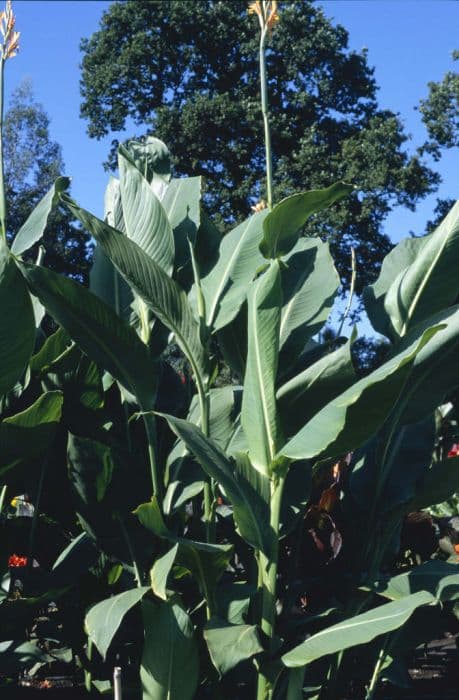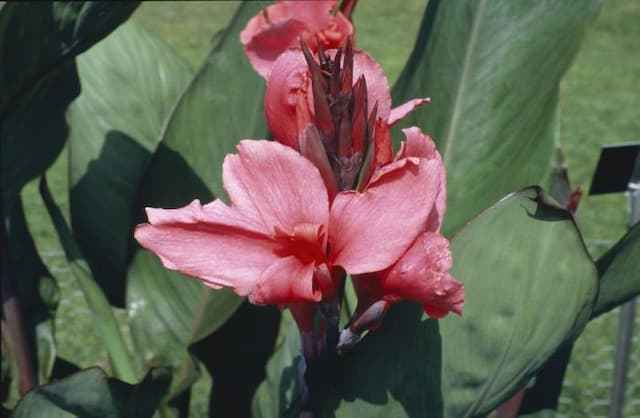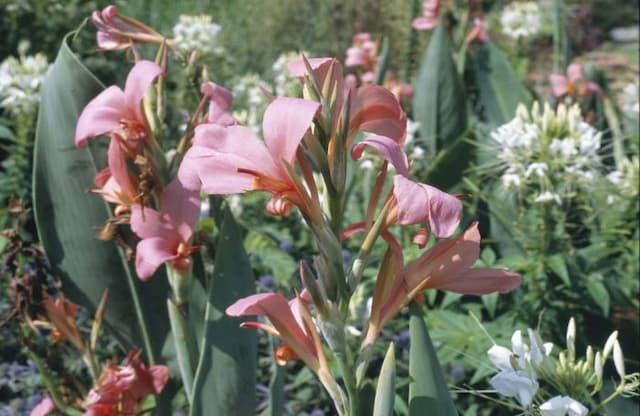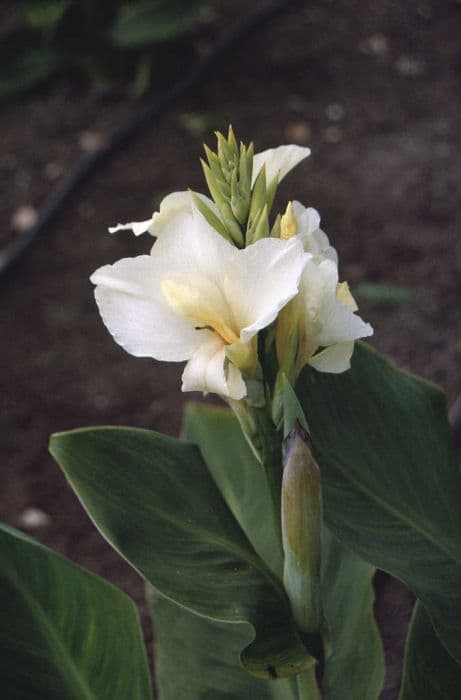Canna Lily Canna 'Endeavour'

ABOUT
Canna 'Endeavour' is a strikingly beautiful plant with vivid, large, paddle-shaped leaves that often come in deep green to bronze shades, providing a lush, tropical backdrop. The true showstoppers are its blossoms, which are bold and bright red, resembling irises in their shape. These flowers are carried on tall spikes that tower above the foliage, and they bloom profusely during the warmer seasons, making it a standout in any garden display. Each individual flower petal is slightly ruffled at the edges, adding to their ornate appearance. The plant overall has a robust and sturdy look, exuding a somewhat architectural quality with its tall flower spikes and broad leaves.
About this plant
 Names
NamesFamily
Cannaceae
Synonyms
Canna Lily, Indian Shot, Arrowroot, Cana de Etiopía
Common names
Canna 'Endeavour'.
 Toxicity
ToxicityTo humans
Canna 'Endeavour' is commonly known as Canna Lily. Cannas are not considered highly toxic to humans. However, like many plants, they may cause mild stomach upset if ingested in large quantities. Symptoms might include nausea, vomiting, or diarrhea. It’s important to note that the seeds can be particularly hard and should not be swallowed as they pose a choking hazard, especially to children. Overall, Canna Lilies are generally safe, but consumption of plant parts should still be avoided.
To pets
Canna Lily toxicity to pets, such as cats and dogs, is generally considered to be low. The plant is not known for being poisonous to pets, but ingestion of plant material may cause mild gastrointestinal discomfort. Symptoms could include vomiting or diarrhea if a pet consumes a significant amount of the plant. It’s always best to prevent pets from eating non-food plants, as individual animals might have sensitivities or allergic reactions. If you suspect your pet has eaten a large amount of any plant and is showing signs of distress, it is recommended to consult a veterinarian.
 Characteristics
CharacteristicsLife cycle
Perennials
Foliage type
Deciduous
Color of leaves
Green
Flower color
Red
Height
4-5 feet (1.2-1.5 meters)
Spread
1-2 feet (0.3-0.6 meters)
Plant type
Herb
Hardiness zones
7-10
Native area
South America
Benefits
 General Benefits
General Benefits- Attractive Blooms: Produces vibrant red flowers that add color and visual interest to a garden or landscape.
- Easy to Grow: Known for being low maintenance and easy to care for, suitable for a wide range of gardeners.
- Drought Tolerant: Once established, canna lilies are relatively drought-resistant, requiring minimal watering.
- Rapid Growth: Can grow quickly to fill in garden spaces, providing a lush, tropical aesthetic.
- Long Flowering Season: Blooms from early summer to the first frost, offering a long season of visual enjoyment.
- Architectural Structure: Has large, banana-like leaves that give structure and a tropical feel to plantings.
- Adaptable: Can be grown in containers or in the ground, providing flexibility in landscaping and garden design.
- Pest Resistant: Generally resistant to pests, reducing the need for chemical interventions.
- Multipurpose Usage: Great for use in borders, flower beds, and as a focal point in a garden display.
 Medical Properties
Medical PropertiesThis plant is not used for medical purposes.
 Air-purifying Qualities
Air-purifying QualitiesThis plant is not specifically known for air purifying qualities.
 Other Uses
Other Uses- Canna 'Endeavour' can be used as a source of biomass. The organically rich matter can be composted or used for bioenergy production.
- The large leaves of the Canna plant can be used in floral arrangements as a bold and exotic backdrop for other flowers.
- Papermaking is another creative use for the fibrous content of the Canna plant's leaves and stalks.
- As a natural dye source, the pigments from Canna flowers and leaves can be used in textile and craft coloring.
- Canna 'Endeavour' can function as a living fence or privacy screen, growing tall and dense to block unwanted views or demarcate areas in a garden.
- The sturdy stalks of the Canna plant can be used in light construction or as stakes for supporting other plants in the garden.
- The seeds of the Canna plant are hard and bead-like; they can be used for making jewelry or in musical instruments as a percussion element.
- In ponds or water gardens, Cannas can provide shelter and breeding grounds for aquatic creatures like frogs and fish.
- By planting Canna 'Endeavour' in erosion-prone areas, their root systems can help stabilize the soil and prevent erosion.
- Cannas can be incorporated into permaculture designs as a 'chop and drop' mulch plant due to their rapid growth and large biomass production.
Interesting Facts
 Feng Shui
Feng ShuiThe Canna is not used in Feng Shui practice.
 Zodiac Sign Compitability
Zodiac Sign CompitabilityThe Canna is not used in astrology practice.
 Plant Symbolism
Plant Symbolism- Vibrancy: The Canna 'Endeavour', also known as Canna Lily, often symbolizes the vibrant and bold aspects of life due to its bright and colorful flowers.
- Confidence: The striking presence of the Canna Lily can represent confidence and pride, as it stands tall and imposes with its lush foliage and flowers.
- Transformation: Given its nature to grow from rhizomes and its ability to reinvent itself each year, the Canna Lily can be seen as a symbol of change and transformation.
 Water
WaterCannas, including 'Endeavour', prefer consistent moisture, especially during their growing season in the spring and summer. Water the plants thoroughly until the water runs out of the drainage holes, which should be about once a week. The actual frequency may vary depending on climate and weather conditions, but the goal is to keep the soil evenly moist, not soggy. On average, during hot weather, they might need around 1 to 1.5 gallons of water per week. Always check the top inch of the soil for dryness before watering again to avoid overwatering.
 Light
LightCannas, including 'Endeavour', thrive in full sunlight, so place them in a location where they can receive at least 6 to 8 hours of direct sunlight each day. They can tolerate partial shade, but too much shade can decrease blooming and the vibrancy of their foliage. An ideal spot is in an area that is shielded from strong winds but still gets ample sunshine.
 Temperature
TemperatureCannas, including 'Endeavour', perform best in temperatures between 60°F and 90°F. They can survive minimum temperatures of around 55°F, but they are not frost-tolerant and can be damaged by temperatures below this threshold. During periods of extreme heat, additional watering may be necessary to keep the plants healthy.
 Pruning
PruningCannas, including 'Endeavour', should be pruned to remove spent flowers and damaged or yellowing leaves to encourage new growth and blooming. Prune the plants periodically throughout the growing season, which is typically from late spring through summer. The best time for major pruning is after the first frost when cannas begin to die back, or in early spring before new growth starts.
 Cleaning
CleaningAs needed
 Soil
SoilThe best soil mix for the Canna Lily 'Endeavour' should be rich, well-draining, and loamy with a pH of 6.0 to 6.5. Amend the garden soil with compost and peat moss to increase fertility and improve drainage.
 Repotting
RepottingCanna Lily 'Endeavour' should be repotted every 2 to 3 years or when it outgrows its container. It’s best to repot in the spring before the growing season begins.
 Humidity & Misting
Humidity & MistingCanna Lily 'Endeavour' prefers high humidity levels but is adaptable to average outdoor conditions. Aim for a relative humidity of around 50-70%.
 Suitable locations
Suitable locationsIndoor
Give Canna Lily 'Endeavour' bright light and keep soil moist.
Outdoor
Plant Canna Lily 'Endeavour' in full sun and enrich soil.
Hardiness zone
7-11 USDA
 Life cycle
Life cycleCanna 'Endeavour', commonly known as Canna Lily, begins its life cycle when a rhizome is planted in the soil in early spring after the last frost. The rhizome sprouts into a seedling and then gradually develops into a mature plant, with large, paddle-shaped leaves and tall stems. Throughout the summer, Canna Lily reaches its flowering stage, producing vibrant red or orange blooms that attract pollinators. After flowering, if pollination occurs, it may produce seeds in a capsule, although many gardeners propagate Canna Lilies vegetatively by dividing rhizomes. As temperatures drop in autumn, the plant enters dormancy, with the aerial parts dying back to the ground. The rhizome overwinters in the soil and will sprout anew when warm temperatures return, completing the cycle.
 Propogation
PropogationPropogation time
Spring-Early Summer
The most popular method of propagating the Canna 'Endeavour' is through division of its rhizomes. Typically, this is done in the spring before new growth begins. Gardeners should carefully dig up the plant, taking care not to damage the rhizomes. With a sharp knife, the rhizomes are then cut into sections, making sure each piece has at least one eye, which is a growth point. These sections are then replanted at a depth of about 3 to 4 inches (about 7.6 to 10.2 centimeters) with the eyes facing upwards. It's essential to water these newly planted divisions well to help establish the plant. This method of division is reliable and allows gardeners to produce new plants that are true to the parent's characteristics.









